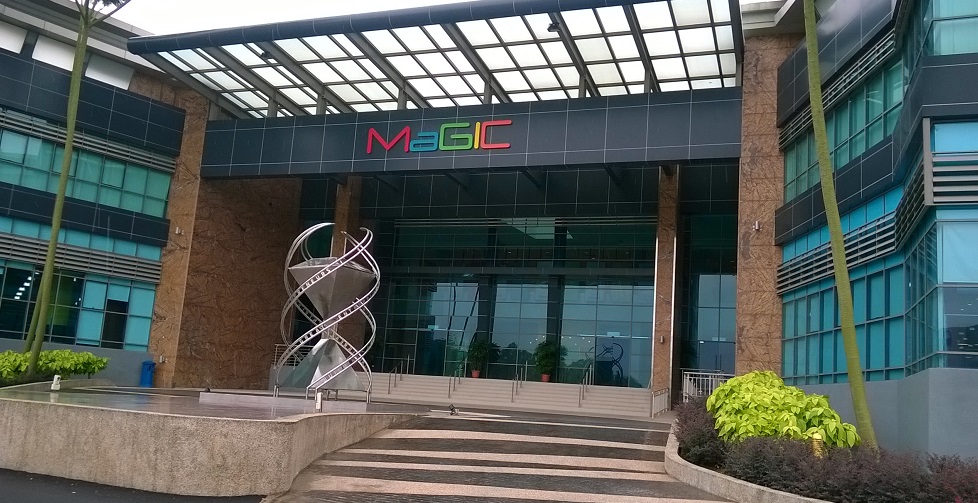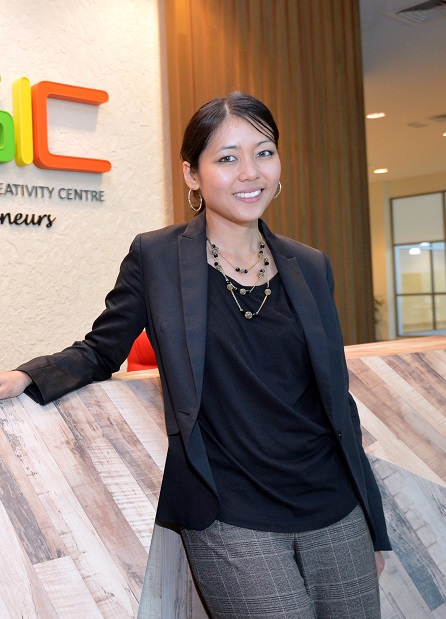The MaGIC CEO and the crucible of fire
By A. Asohan September 11, 2014
- Undaunted by criticism, Cheryl Yeoh believes MaGIC has important role to play
- Notes that it is the only end-to-end agency dedicated to entrepreneurship

THE newly-renovated building for the one-stop shop for entrepreneurship, the Malaysian Global Innovation and Creativity Centre (MaGIC), stands out in its cul-de-sac in the sparkly high-tech city that’s Cyberjaya.
The building used to be a ‘Knowledge Development Centre’ run by national ICT custodian Multimedia Development Corp (MDeC), so it hasn’t strayed far from its heritage. It’s squeaky-clean – and in the case of the just-polished floors at the reception centre when Digital News Asia (DNA) paid a visit late last month, literally so.
When DNA is ushered in to a meeting room to interview MaGIC chief executive officer Cheryl Yeoh, there is a stark contrast between her demeanour and the building’s façade. She looks like she has not been getting enough sleep, and missing one meal too many.
“I feel thin, sort of stretched, like butter scraped over too much bread,” Bilbo Baggins told Gandalf in J.R.R. Tolkien’s (not Peter Jackson’s) The Lord of the Rings, and you feel as if Yeoh can empathise fully.
But as she speaks about MaGIC and what it will be doing over the next few months, the sparkle and energy return.
MaGIC has just ended its ‘quiet period,’ and Yeoh is now starting to engage with the media after a fact-finding phase it entered in the wake of its official launch in April this year, attended by no less than US President Barack Obama and Malaysian Prime Minister Najib Razak.
It was Najib who had first announced the establishment of MaGIC at the Fourth Global Entrepreneurship Summit (GES) in Kuala Lumpur last October, and the GES itself is an initiative by the Obama Administration to boost the economies of emerging countries through entrepreneurship.
When she first took on the CEO role, Yeoh told DNA, “Give me some time to settle in, get to know the ecosystem better so that I can then [put] a more structured programme in place.”
She’s spent the last four months doing that, and it has not been easy, by all accounts. The Malaysian-born former entrepreneur who made it in Silicon Valley has had to come back home to face what must have been a culture clash from the more meritocratic environment she was used to, according to people who have been engaging with her in the last four months.
Coming from the private sector into a government agency such as MaGIC would require some getting used to for anyone, her sympathisers point out. Even her critics – ecosystem players and entrepreneurs – can empathise with that.
Indeed, the main criticism against her that DNA has gathered, is that many people believe she’s trying to do too much. “MaGIC does not have to do everything,” they say. “She [Yeoh] is going to burn out at this pace.”
“We’re building an entire ecosystem here,” Yeoh tells DNA, but adds that MaGIC does not intend to duplicate what’s already out there. “We want to fill the gaps and connect the dots.”
“We spent the first two months, after hiring the core team, engaging with nearly 200 entrepreneurs from different lifecycles – from the ideation stage all the way to the mature stage – to identify the gaps. Because when we look at the ecosystem, we want to look at the entire lifecycle.
“We also spoke to the various government agencies to find out what they were all doing, so that we could try and figure out the gaps that we would need to plug,” she says.
Being the bridge

But the criticism persists. What is MaGIC doing that’s not been done elsewhere?
“Why I haven’t engaged with the media before this, is because I didn’t want to fly in and tell the ecosystem: This is what needs to be done” says Yeoh (pic).
“I needed to do my homework and talk to people, the players. So that was the first four months.
“What is MaGIC doing? It’s very different. We’re building an ecosystem. It’s not like we’re just running programmes, or being a funding agency. We may be a government-funded agency, but we want this organisation to be very entrepreneurial-minded,” she says.
“Brad Feld wrote a book [Startup Communities: Building an Entrepreneurial Ecosystem in Your City] where he says that entrepreneurs have to be leaders of the ecosystem, and government cannot be leaders, they can only be feeders – providing the resources, the policies and the tools – because they would implement all kinds of scoring systems and metrics, and all these kinds of things are just road-blockers for entrepreneurs.
“So MaGIC is an intermediary. It has, in a way, the body of a government, and the resources and support of government, but it is ultimately run by entrepreneurs. We’re an intermediary to bridge the gap between what entrepreneurs really, really need; and then connect them to all the resources provided by the Government,” she adds.
In the four months after taking on the CEO role, Yeoh and her team – MaGIC now has a core of 15 full-time staff, and is aiming for 25 by year-end – did what they called “mapping out the ecosystem.” This included determining all the public sector agencies and private sector bodies which play some role in entrepreneurship.
“The second difference is that we are looking at the whole ecosystem, the whole lifecycle, while many of the agencies only focus on certain aspects, like funding – there isn’t an end-to-end type agency.
“But more than that, we’re taking startups to the next level – to the regional or global level, which is why the term ‘global’ is in our name,” she adds.
Still, many of the programmes and initiatives that MaGIC is running, or intends to run [more of that tomorrow – ED] – training, accelerators, technical bootcamps, etc. – are already being conducted by others parties too. Isn’t this a duplication of effort?
Yeoh admits there are some overlaps, and not only between MaGIC and the rest, but also between what some agencies are doing – but she’s adamant that what MaGIC has laid out is well within its mandate, which is to catalyse Malaysia into a regional startup hub.
“Here’s my take: I think the public is very cynical because to them, all these things are the same. But that’s why we’re mapping them [the agencies] out – to determine their goals and their resources.
“There may be some overlaps, but not many – and I can vouch for this. There are some, but they all fill different kinds of entrepreneurship – like those in agriculture, small and medium enterprises, and so on – and then, in each sector, there are different lifecycles.
“There are funding systems, there are incubators, there are programmes, there are mentorship initiatives, and more.
“I don’t want this mindset to persist, that it’s a zero-sum game, or that one agency takes all. It can be a win-win situation.
“Collectively, there is a lot of stuff – the problem is visibility, transparency and awareness. When people hear about all these programmes, but they don’t understand what they do, it all just sounds the same.
“So when we map it out into the lifecycles of the various sectors, we can see, okay, there are only four or five agencies in this. It all becomes very clear.
“It’s awareness, I think. People are criticising MaGIC because it sounds like we’re doing the same things, but it’s not the same – we’re filling in the gaps, and we’re connecting the dots,” she says. “MaGIC is about working in the ecosystem, with our partners.”
Next Page: Numbers, metrics and pressure


